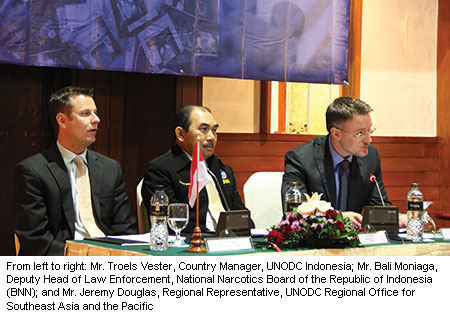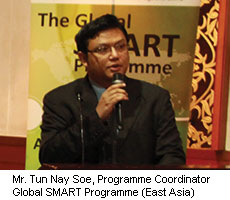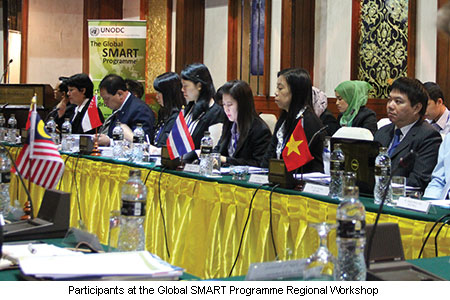New psychoactive substances also emerging on illicit drug markets

Jakarta (Indonesia), 2 September 2013 - The methamphetamine problem in East and Southeast Asia remains the greatest drug challenge in the region and it continues to worsen, said delegates who attended the UNODC Global Synthetics Monitoring: Analyses, Reporting and Trends (SMART) Programme regional workshop held in Jakarta on 28-29 August 2013.
The manufacture, trafficking and use of amphetamine-type stimulants (ATS) - primarily methamphetamine in pill and crystalline form - have continued to expand throughout the region in recent years. Preliminary data for 2012 suggest that methamphetamine seizures in the region have reached near-record levels.
"The response to the illicit drugs problem in the region has been constrained due to the disparate levels of information and capacities of the countries", said Mr. Jeremy Douglas, Regional Representative, UNODC Regional Office for Southeast Asia and the Pacific. "This has restricted awareness and limited cooperation among countries and agencies."
 Indonesia is a manufacturing centre and destination point for the trafficking of crystalline methamphetamine and ecstasy. The use of crystalline methamphetamine, in particular, has expanded swiftly throughout the country, both geographically and demographically. The crystalline methamphetamine trade alone generates an estimated USD 1 billion in revenue per year in Indonesia.
Indonesia is a manufacturing centre and destination point for the trafficking of crystalline methamphetamine and ecstasy. The use of crystalline methamphetamine, in particular, has expanded swiftly throughout the country, both geographically and demographically. The crystalline methamphetamine trade alone generates an estimated USD 1 billion in revenue per year in Indonesia.
"There has been an increasing level of transnational organized criminal activity in the illicit drug trade in Indonesia," said Mr. Troels Vester, Country Manager, UNODC Indonesia, at the workshop today at the Sari Pan Pacific Hotel in Jakarta. "Transnational organized criminal groups are very powerful," Mr. Vester added. "The revenues can be reinvested in terrorism and other criminal activities."
"The illicit trade in ATS and other synthetic substances not only fuels a rise in organized crime but also poses a public health threat," said Mr. Bali Moniaga, Deputy Head of Law Enforcement, National Narcotics Board of the Republic of Indonesia (BNN). Mr. Moniaga also expressed concern about the emergence of new psychoactive substances in Indonesia, a trend which is reflected in several countries in East and Southeast Asia.
New psychoactive substances (NPS) are often marketed on illicit drug markets as "legal highs", or licit alternatives to controlled substances. NPS mimic the effects of illicit drugs and are produced by introducing slight modifications to the chemical structure of controlled substances to circumvent drug controls. In addition to the health risks posed by NPS, the fast-paced nature of this market, the increased availability of these substances and the reports of increased and emerging use of and trade in such substances have drawn concerns that transnational organized criminal groups may try to exploit the market for these substances.
Global SMART Programme Regional Workshop participants discussed the threats and challenges posed by the emergence of NPS and exchanged information on the regional synthetic drugs situation and national responses to it. They were also updated on the Programme's implementation and future regional SMART implementation steps including the data-sharing Drug Abuse Information Network for Asia and the Pacific (DAINAP).

Participants included more than 40 law enforcement officers, intelligence analysts, health practitioners, forensic scientists, and delegates from the 10 SMART UNODC partner countries - Brunei Darussalam, Cambodia, Indonesia, the Lao People's Democratic Republic, Malaysia, Myanmar, the Philippines, Singapore, Thailand and Viet Nam.
Representatives from the World Customs Organization Regional Intelligence Liaison Office Asia and the Pacific, the Korean Customs Organization and the Australian Federal Police delivered informative and thought-provoking presentations on the latest trends in trafficking of synthetic drugs in East and Southeast Asia. The Embassy of Japan in Indonesia, U.S. Drug Enforcement Agency and Bureau of International Narcotics and Law Enforcement Affairs were also represented.
The data shared by the eleven partner countries and additional findings gathered during the workshop will be reflected in the Global SMART Programme's annual ATS report, Patterns and Trends of Amphetamine-Type Stimulants and Other Drugs, Asia and the Pacific. The 2013 report will be published this coming fall. The Programme also publishes the semi-annual Global SMART Update to provide regular brief reporting on emerging patterns and trends of the rapidly evolving global synthetic drug situation.
Background - the Global SMART Programme
UNODC launched the Global SMART Programme in September 2008 to enhance the capacity of member states and authorities in East and Southeast Asia to generate, manage, analyse and report synthetic drug information, and to apply this evidence-based knowledge to policy and programme design.
The UNODC Global SMART Programme receives financial support from the Governments of Australia, Canada, Japan, New Zealand, the Republic of Korea, the Russian Federation, Thailand, the United Kingdom and the United States.